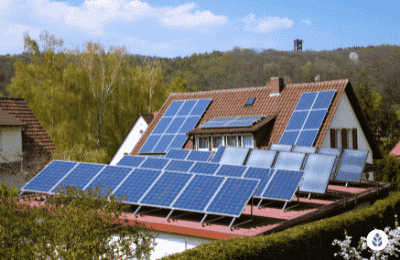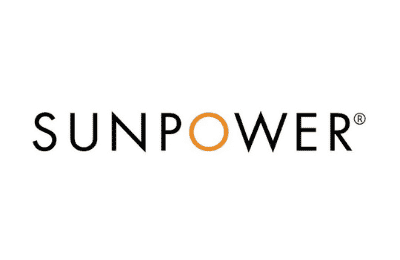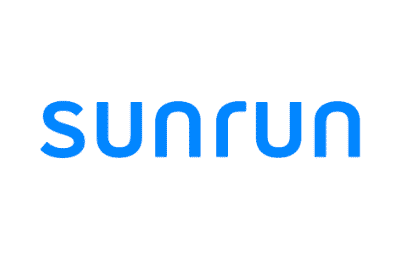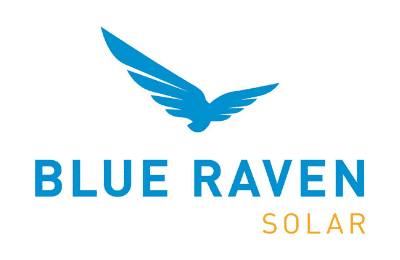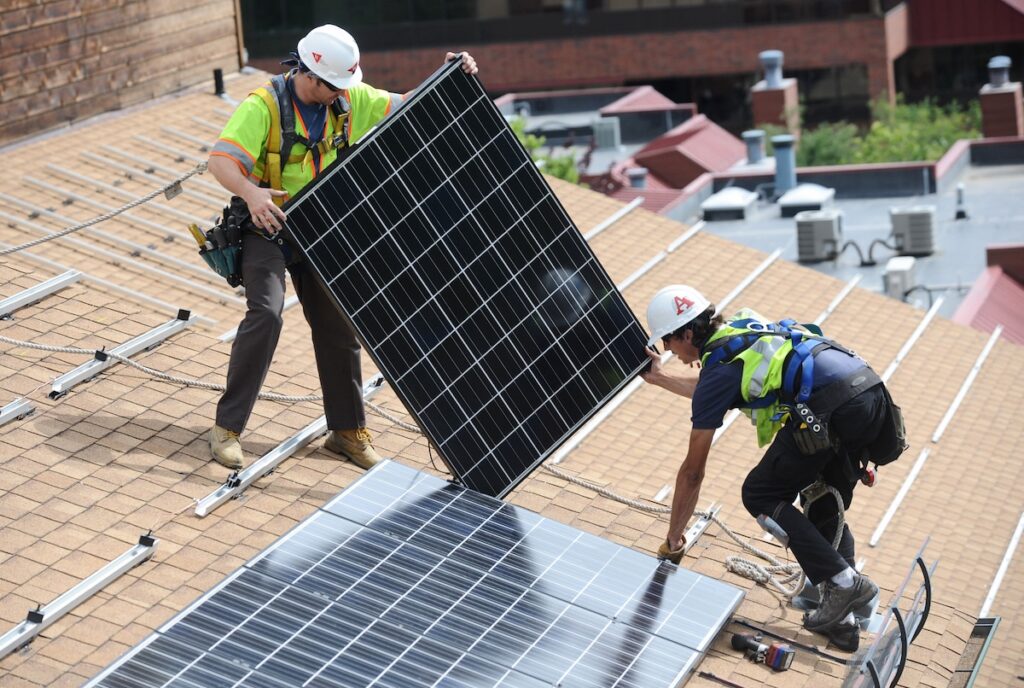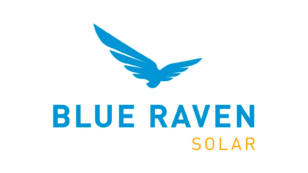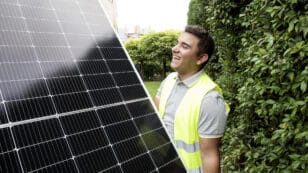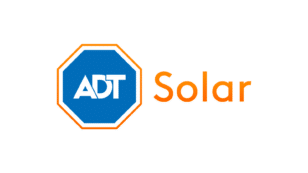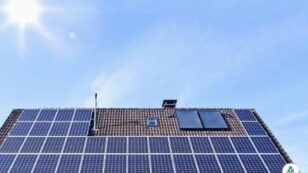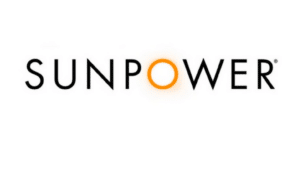
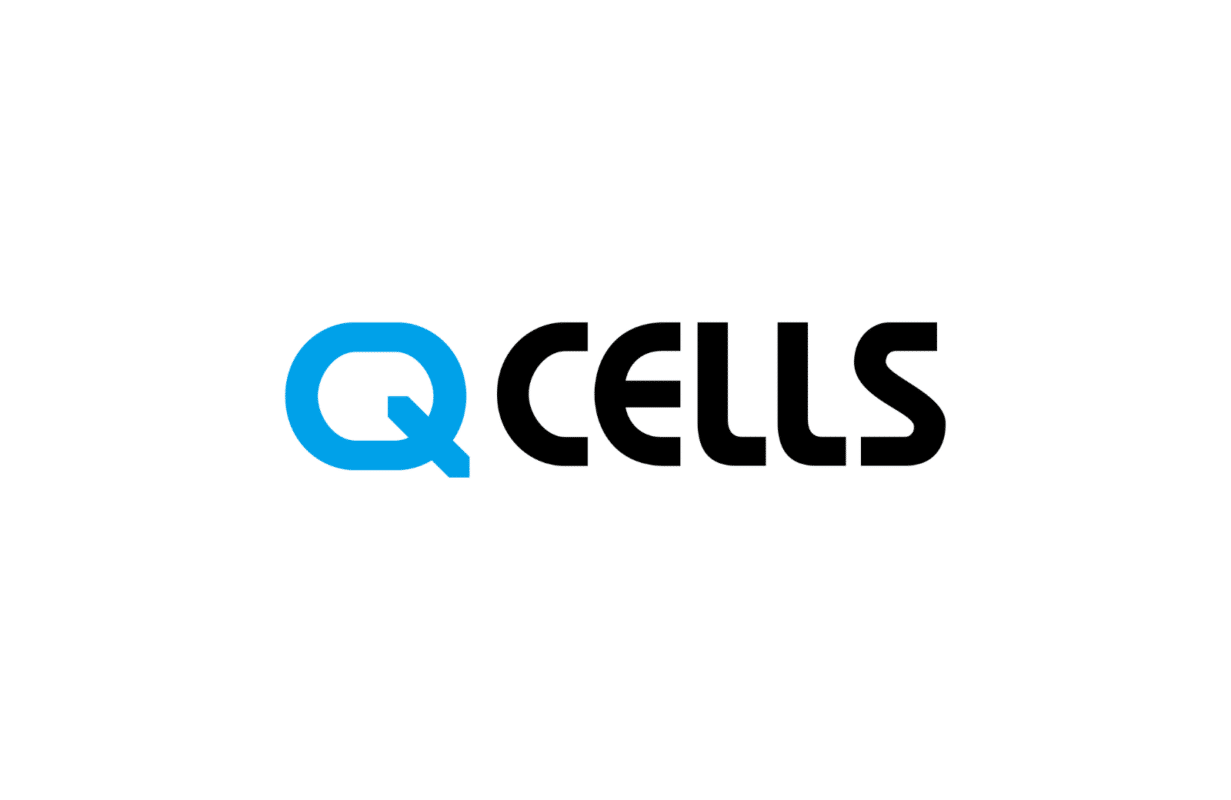
QCells Solar Panels Review (2024 Cost, Efficiency & Performance)
Here’s what you need to know about Qcells solar panels:
- EcoWatch Rating: 4.5 Stars
- Efficiency: 19.6% to 21.2%
- Power Rating: 360 to 415 W
- Warranty Length: 25 Years
Each product and or company featured here has been independently selected by the writer. You can learn more about our review methodology here. If you make a purchase using the links included, we may earn commission.
Hanwha QCells — often just referred to as QCells — is a tier-one monocrystalline solar panel manufacturer that is well-known in the solar industry for providing high-quality, high-performance panels. This South Korean company is based in Seoul, and it maintains additional headquarters and locations in Germany, Australia, North America, South America, Malaysia and China.
QCells panels regularly rank as some of the best solar panel options for residential use, and we recommend these to customers looking for high efficiency ratings and solar energy production at a great price. In this QCells review, we’ll be discussing its products in depth and explaining why we think these panels are wonderful for use in residential solar arrays.

Q Cells
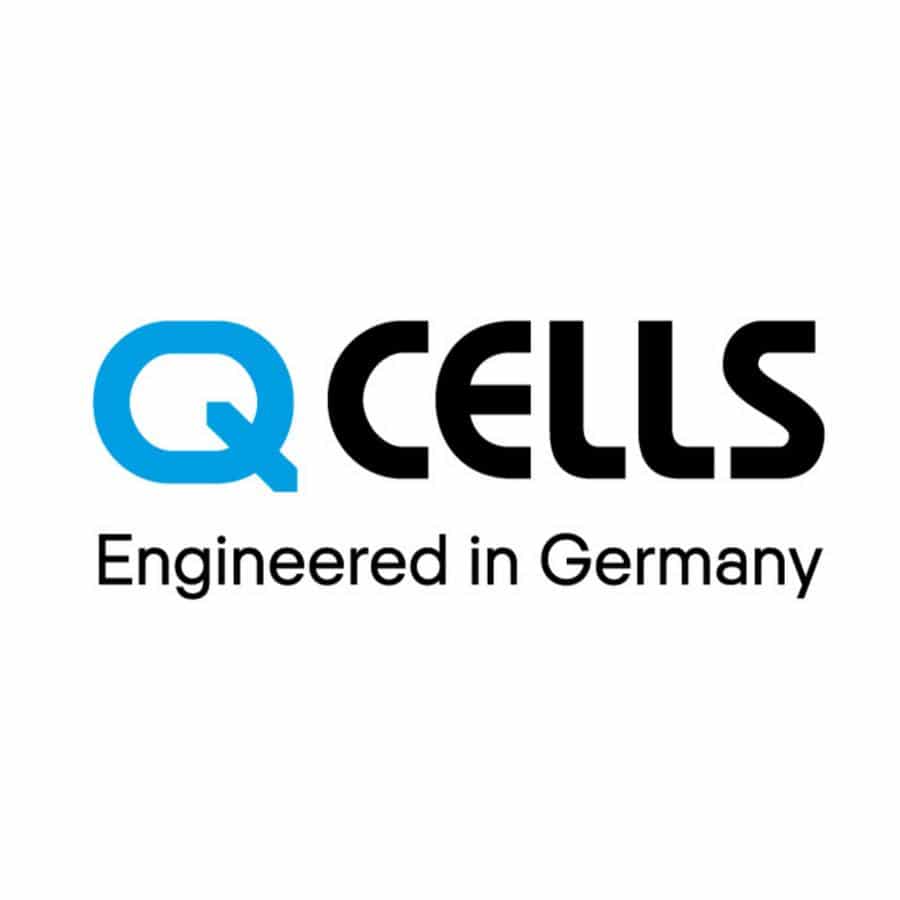
Average cost
Pros
- Competitively priced
- Highly efficient
- Work well in high temperatures
Cons
- Only one type of technology available
Does QCells Make Good Solar Panels?
Yes, QCells makes an outstanding product, known for above-average efficiency ratings, excellent durability and a price per watt that is a bit lower than most comparable panel brands.
In addition to the energy production capabilities, QCells panels feature a slew of other impressive performance specifications, like a below-average first-year efficiency degradation, a higher resiliency to intense winds than most other brands and overall sustainability, with panels made using recycled materials and a solid end-of-life program for recycling old panels.
Overall, we believe QCells is one of the best brands for property owners looking to balance efficiency and cost.
In the following sections, we’ll take a look at the two panel options QCells has available for residential use.
QCells Q.PEAK DUO BLK-G10+ Solar Panels
The Q.PEAK DUO BLK-G10+ panels from QCells are all black, which most solar customers prefer the look of, and feature no visible grid lines, so they look super sleek and modern. More importantly, they boast an above-average efficiency rating of 20.6%, which means they deliver more power output per watt than average to help maximize your production and solar savings. These panels have a slightly lower efficiency than the other model, but they’re still considered high-performance.
At between 350 and 370 watts, these are smaller than the ML-G10+ panels and a little smaller than most other residential panel options, so they might be ideal for you if you have limited roof space.
These panels also have a temperature coefficient of -0.34% per degree above 77 degrees (F), which is slightly better than the average among tier-one panels and far better than the industry average. This means your panels should outperform many other models in high temperatures, making them a good option in warmer climates.
Finally, they have above-average wind and snow resistance, so they’re a great panel to install if you see extreme weather. The snow load they can handle is about 1.5x the industry average, so these are a great option if you live in an area that sees above-average snowfall.
QCells Q.PEAK DUO BLK ML-G10+ Solar Panels
Compared to the previous model, the ML-G10+ panels have a higher efficiency rating of 20.9%, which means they’ll generate more usable electricity for your home in all conditions, including cloud cover. These are a little more expensive on a per-watt basis, but we feel the better performance is well worth the added investment.
These have a lower snow resiliency than the Q.PEAK DUO BLK-G10+ panels, coming in at 5400 Pa as opposed to the 8100 Pa you’d get with the other model. For most states in the U.S., though, the industry-standard 5400 Pa should be sufficient.
These panels are larger than the other QCells model and are more in line with what you’d see from other manufacturers in terms of size at between 385 and 410 watts. They might not be ideal for particularly small roofs, but they should be suitable for most solar customers. However, these panels have 132 half-cut solar cells, whereas the BLK-G10+ has 120, so they do produce more energy per square inch.
What Technology Does QCells Use In Its Solar Panels?
For the most part, QCells uses standard technology that is considered to be at the forefront of solar tech progression but is also used by many other manufacturers. Things like half-cut solar cell technology, PERC cells, numerous busbars and reflective backings to reduce solar power loss are used by QCells but are also more or less ubiquitous in the tier-one monocrystalline solar module space.
However, there are a few innovations QCells has made to improve panel performance that are proprietary or at least less common among other manufacturers. We’ll discuss these solar technologies in the following sections.
Q.ANTUM Technology
QCells is perhaps best known for its Q.ANTUM technology, which combines a variety of solar advancements to improve solar module performance and longevity. These include the following:
- Zero-gap solar cell arrangement, which overlaps cells on the non-producing edges to maximize production per square inch
- Passivation layers, which help reduce the amount of solar energy lost through the rear side of the panel, thereby improving performance and production
- Anti-reflection coatings, which reduce the amount of solar energy that is reflected off the front of the solar cell, thereby providing maximum energy for the interior of the panel to absorb and convert to electricity
Combined, these technological advancements help boost the panel efficiency and performance, which should lead to greater energy savings for you down the line. Additionally, these individual technologies are used by other manufacturers but not always in combination like they are in QCells panels.
Anti-PID and Anti-LID Technology
QCells panels are also well known for their durability and resistance to performance problems that can be prevalent in modules from other manufacturers. Specifically, QCells implements anti-PID (potential induced degradation) and anti-LID (light-induced degradation) technologies to reduce the issues you’re likely to see with your system.
PID is caused by differences in the potential of different materials within your panel, namely, the silicon solar cell and the surrounding materials. When the solar cells heat up during production, tension is created between the materials that can lead to accelerated panel degradation and efficiency loss. LID is similar, but it is directly caused by exposure to sunlight.
QCells not only implements technologies to avoid these issues and efficiency losses — including “Hot Spot Protect” and other non-proprietary safety measures — but it also puts its panels through a more rigorous testing protocol to ensure the panels that make their way to customers are more or less guaranteed not to have any issues.
Overall, the inclusion of this tech helps ensure your panels perform as expected. Plus, the testing they go through makes QCells one of the brands that is least likely to run into performance issues and interior panel damage.
Tra.Q Laser Technology
QCells also uses its Tra.Q laser technology, which engraves all panels with trackable serial numbers. This accomplishes two things.
First, it helps QCells put its panels through rigorous and extended testing while maintaining the ability to trace issues back to the source to fix them before panels ever make their way to customers. That means more reliable panels overall and fewer issues once they’re installed on your home.
Second, it allows QCells to reduce the number of forged solar panels. This ultimately protects consumers from underperforming modules and helps the company maintain its brand identity.
Here’s a quick look into Qcells’ newest manufacturing facility in Dalton, GA — the largest solar panel factory in the western hemisphere.
How Do QCells Solar Panels Perform in Different Climates?
There are a few things you need to consider about your climate before you choose solar panels to install on your roof. These include wind resistance, snow resistance, temperature coefficient and overall efficiency rating.
Areas With Intense Wind
Wind resistance is an important factor if you live in an area that is prone to hurricanes, tropical storms, tornadoes or other severe weather conditions that produce intense winds. The higher a panel’s wind resistance, the more likely it is to stay firmly attached to your roof and intact through extreme weather.
The two panel models from QCells both have a 4,000 Pa max wind load, which is above the industry average of 3,000 Pa. That means QCells panels will hold up better in extreme winds than most other brands.
Areas With Above-Average Snowfall
If you live in an area that sees above-average snowfall, you’ll want to check the max snow load of your panels. Panels with higher load capabilities will persist without any issues, even when under large amounts of snow.
The average max snow load among tier-one panels is 5,400 Pa. The ML-G10+ panels from QCells match this average, but the BLK-G10+ panels can handle an impressive 8,100 Pa from snow pressure. That makes them one of the most durable panel models for areas that see heavy snowfall.
Hot Climates
All solar modules lose efficiency as temperatures increase. The temperature coefficient of a solar panel tells you how much of the starting efficiency is lost per degree the ambient temperature rises above 77 degrees (F). The lower the temperature coefficient, the more power your panels will maintain as temperatures rise.
Both QCells panel models have a temperature coefficient of -0.34%, which is slightly better than the average of -0.35% for tier-one panels. That means QCells outperforms most comparable brands in higher temperatures, making them a great option in hotter climates.
Areas With Low-Sun Conditions
Finally, it’s important to consider the overall panel efficiency rating, as this dictates how much electricity your panels will generate in all conditions. Higher efficiency ratings mean greater savings in the long run in most cases, and they sometimes mean you can get away with installing fewer panels, which is ideal for homeowners with small roofs.
QCells panels have above-average efficiency ratings reaching up to 20.9%. This means they will perform better than most other options in all conditions and that they’re particularly good for homeowners who live in areas that see less sunlight than average.
Does QCells Make Any Other Solar Products?
Yes, in addition to solar panels and the interior components, QCells manufactures a solar battery and offers a solar monitoring app to act as a complete energy management tool. We’ll explain what these products do for users in the following sections.
QCells Solar Battery
The Q.HOME CORE H3S/H7S is a solar battery manufactured by QCells. Solar batteries serve two main purposes. The most beneficial is providing access to effective net metering by allowing you to store excess energy generated by your panels and use it to offset energy consumption when your panels underproduce, like at night or on cloudy days.
The second benefit that most homeowners are already aware of is letting you maintain electricity through power outages.
The Q.HOME CORE is available in sizes ranging from 10 kilowatt-hours (kWh) to 20 kWh, and it integrates seamlessly with Enphase inverters and other brands to provide power to specific portions of your home if desired.
QCells Solar Monitoring App
QCells also has its own solar monitoring app that you can install on a smartphone or tablet. The app gives you real-time performance information, including your production, consumption and energy storage if you have a battery installed.
The app is convenient for monitoring your home’s energy consumption and production, and it can also give you control over how your power is used to boost savings.
How Much Do QCells Solar Panels Cost?
Like panels from all manufacturers, QCells panels range in price based on your location and the solar contractor you hire to install them. However, the average cost per watt is around $3.47.
This is above the national average of $3.33, but it’s below what panels from most direct competitors cost. Panel brands with similar efficiency ratings and performance specs typically cost around $3.67 per watt.
That means that a typical 9 kilowatt (kW) system composed of QCells panels would be around $31,230 before any incentives, which is about $1,800 less than a system made up of panels from a direct competitor with similar specifications. This assumes you use the average amount of electricity and need the same system size as most U.S. residents.
If you opt to add a QCells battery to that system — which costs around $11,950 — your price would go up to $48,650. After the federal investment tax credit (ITC), that could get knocked down to $34,055.
QCells Financing Options
QCells doesn’t sell its products directly to consumers, so it doesn’t offer any specific financing options. Instead, you’ll need to contact a local solar panel installer to tackle your installation, and your financing options will depend on what that solar contractor accepts.
There are four main ways to pay: with cash, with a solar loan, with a solar lease or by entering into a power purchase agreement (PPA).
Paying in cash is what we recommend most if you can afford it. You’ll pay the most upfront, but you’ll own your panels immediately and won’t pay interest on your equipment. That means the panels will pay for themselves in the shortest amount of time possible, and you’ll see the highest solar savings in the long run.
A solar loan is the next best option, as it’s the only other one that leads to panel ownership. As such, loans and cash payments are the only options that let you take the federal credit, which holds an average value of over $8,991 in the U.S.
A loan will require that you pay interest, which ultimately pushes up your all-in system total and reduces your savings a bit. However, your savings are still going to be much higher than they would be with a lease or PPA.
A lease is where you rent the panels and get to use all the energy they generate to save money on your utility bills. Leases save less than cash and loans, and they prevent you from taking the federal credit since you’ll never own your panels. However, leases don’t have the same down payment requirements as cash purchases, and they have less strict credit score requirements than loans.
A PPA is where you sign a contract to get panels installed at no upfront cost, and you agree to buy energy at a below-retail rate from your installer for the duration of the contract. These save the least amount of money, but they’re a low-cost option for converting to clean energy. This is the option we recommend least often, though, due to the limited savings.
It’s also worth mentioning that leases and PPAs can sometimes complicate the sale of your home if you want to move before the term is up. They also don’t boost your home value as a cash payment or loan would.
How Can You Save Money on QCells Solar Panels?
There are a few ways you can save money on QCells panels through your installer. We’ll explain some money-saving tips in the following sections.
Take All the Solar Incentives You Can
One of the best ways U.S. solar customers can save on their photovoltaic (PV) systems is to take advantage of solar incentives and rebate programs.
The federal solar tax credit is one of the best incentives you can take, and it’s available to all taxpayers. It credits your income taxes owed with 30% of your solar installation costs, which averages over $8,991. This perk can decrease your effective system costs by nearly a third, making it one of the most appealing incentives in the country.
You might have other incentives available to you from your state, municipality or electric company. We recommend you check the Database of State Incentives for Renewables and Efficiency (DSIRE) to see if there are any local perks you can take advantage of.
Consider QCells Batteries Carefully
Another way to save is to think carefully about installing a QCells solar battery. Depending on your specific situation, a battery installed alongside your panels could improve savings or significantly detract from them.
If you live in an area that has a good net metering program — meaning it’s available and the credit rate for excess energy is at least close to the retail rate — then installing a QCells battery will increase your installation costs by around $12,000 but won’t improve your savings at all. If that’s the case, we recommend against installing a battery.
If you live in an area without net metering, then installing a battery will still bump up your installation costs but will very likely pay for itself over time and provide additional savings above and beyond the cost of the battery. If you don’t have access to net metering, we recommend considering a battery to boost your savings over time.
Get Multiple Quotes
Finally, since the cost of QCells panels depends partially on your installer, you could stand to save some money on your system by getting quotes from a few different installers.
Some companies will mark up the panels from QCells, and every installer charges different amounts for the labor to install the panels. You could save hundreds or even thousands of dollars on your QCells system simply by shopping around and finding the most affordable installer that still meets your needs.
QCells Solar Panel Warranty
Like most manufacturers, QCells includes an equipment warranty, which protects you from issues related to manufacturer defects, as well as a performance warranty, which guarantees a minimum efficiency and production rate from your panels. Both of these warranties last for 25 years. The equipment coverage is average, but the efficiency warranty is about five years longer than the industry average.
There are a few things to note about the warranty coverage from QCells and how it differs from what other panel manufacturers provide.
First, QCells puts its panels through a more rigorous testing protocol than most other manufacturers. While the warranty that covers manufacturer defects is in line with the industry average, QCells panels as a whole are more reliable than most and are less likely to experience issues related to the manufacturing process.
That means more peace of mind that you won’t need to make a warranty claim, and it also means you’re less likely to miss out on energy savings while you wait for warranty claims to be addressed, which can take weeks.
Additionally, the performance warranty from every manufacturer differs a bit. QCells guarantees no more than 2% panel degradation within a year of installation, which is better than the 2.5% guaranteed by most other manufacturers.
In subsequent years, QCells guarantees no more than 0.45%, which is less appealing than the tier-one average of 0.4%. Over the first 25 years of your panels’ lifespan, QCells panels will retain a minimum of 87.2% of their starting efficiency. The average for other panels is 87.9%. That means QCells panels are a little below average in terms of efficiency degradation, which could mean slightly less impressive savings over time.
How to Get QCells Solar Panels Installed
QCells doesn’t install its own products, so the process for getting QCells panels installed will be similar to what you’d expect for most other manufacturers. You’ll need to find an installer in your area that works with QCells panels, get a quote and then proceed with the third-party installation. We’ll detail the process below so that you know exactly what to expect at every step of the way.
- Step 1 — Request a quote: The first step will be to find a local solar installer and reach out to request a quote. You’ll usually need to provide a copy of a recent energy bill so that the installer can get a sense of your monthly energy needs. They’ll then schedule an inspection to measure your roof and make sure it won’t need to be replaced before you install panels.
- Step 2 — Inspection and system design: Next, a representative from the company will come out to your house to inspect your roof. They will also need access to the interior of your house to inspect your electric box, your water meter and any areas where you want add-on products like batteries installed. The design team will then come up with a system design that suits your energy needs.
- Step 3 — Contracts: Next, you’ll get a contract, which is the formal solar proposal. This includes all the information you need about your system, including expected power output, potential savings and the cost before and after any incentives available to you. Once you sign the contract, your home solar project will progress to the permitting and planning stage.
- Step 4 — Permitting and planning: At this point, your installer will start to pull permits for your system with your local building department. They will also order the QCells panels and batteries that you need for your system, if applicable.
- Step 5 — Installation: Finally, your installer will schedule your installation and arrive on that day to install your solar PV equipment. The installation typically takes a day or two, and you should plan on being home the entire time the team is on site.
- Step 6 — Interconnection: After the system is installed, your solar contractor will schedule final inspections. One set of inspections will be to close out your building permits, and the other will be with your utility company to set you up for interconnection, which is what connects your system to the grid. Once these inspections are completed, your system can be turned on and will start producing power for your home.
- Step 7 — Solar monitoring: After the installation, it will be up to you to make sure your panels continue performing as expected. You can use the QCells solar monitoring app for this purpose, which your installer should set up for you and show you how to use.
The table below includes a quick look at some of the best solar companies that work with QCells products.
| ADT Solar | Tesla | Momentum Solar | |
| Year Founded | 2008 | 2004 | 2009 |
| Areas Served | 32 states | 50 states | 11 states |
| Better Business Bureau (BBB) Rating | A+ | A+ | A+ |
| Services Offered | Solar panel and battery installations | Solar panel, battery and EV charger installations; solar roof | Solar panel and battery installations |
| Payment Options | Cash and solar loans | Cash, solar loans, solar leases, PPAs | Cash, solar loans, solar leases, PPAs |
| Relative Cost ($-$$$$$) | $$$ | $$ | $$$ |
| Workmanship Warranty Offered | 25 years | 10 years | 25 years |
| Overall Rating (Click for Review) | 4/5 | 4/5 | 4.5/5 |
To find a reputable QCells installer in your area, you can use the tool below to search by zip code. This will provide you with reliable companies that carry QCells products to meet your needs and suit your budget.
Customer Reviews of QCells Solar Panels
Most solar customers leave reviews for solar installers and not manufacturers like QCells, so it’s very difficult to say with certainty how pleased people are with QCells panels themselves. With that being said, we’ve read reviews for installers that almost exclusively work with QCells products to get a sense of the overall customer sentiment toward this brand.
Generally speaking, most customers are very pleased with the quality and performance of the QCells brand, and there were few complaints about the products. We’ll summarize what we’ve found in the following sections.
Positive Reviews of QCells Solar Panels
Most customer reviews that involved installers that work with QCells panels are overwhelmingly positive. The majority of them mention that the quality and performance of the panels are excellent and specifically that warranty claims that should be covered are actually covered.
Most importantly, most customers who haven’t had issues with their installers, specifically, have seen outstanding power production and subsequent energy savings from their QCells panels. Some comment on how affordable the system is, especially when considering the quality, resistance to extreme weather and the savings you’ll see from them over time.
Negative Reviews of QCells Solar Panels
There really isn’t much in the way of negative reviews for QCells panels. There are, of course, negative comments pertaining to the panels, but it seems clear that most of them — if not all of them — target the installer and not the manufacturer.
Overall, QCells is a durable and reliable solar panel brand that garners very little in the way of negative attention and customer reviews.
QCells vs Other Solar Panel Manufacturers
In our opinion, QCells is an outstanding brand of solar panel to consider if you’re looking for above-average power production and performance on a budget.
The efficiency of QCells panels pales in comparison to the industry leader, Maxeon/SunPower, which boasts efficiency ratings of 22.8%. However, for the money, QCells is still a worthwhile option to consider if you don’t need the absolute maximum production, as you might in areas that see more frequent rainfall or cloudy weather.
Plus, it’s worth considering that QCells panels have an above-average efficiency rating but boast a per-watt price that’s $0.30 less than most direct competitors and $0.53 per watt less than Maxeon. For the money, QCells is one of the best brands you can choose, in our opinion.
The durability of QCells panels also stands up to what you’d expect from other direct competitors, and, in many cases, the extensive testing the panels go through leads to fewer issues with manufacturer defects. All of this means more reliability and fewer performance issues for you and your system.
The table below pits QCells panels up against some of its direct competitors to give you a sense of how the brand stands up to other options.
| QCells | REC | Panasonic | Silfab | SunPower | |
| Max Efficiency Rating | 20.9% | 22.3% | 22.2% | 21.4% | 22.8% |
| Power Tolerance | -0%/+5% | -0%/+5% | -3%/+3% | -0%/+10% | -0%/+5% |
| Temperature Coefficient | -0.34% | -.032% | -0.26% | -0.39% | -.027% |
| Degradation Per Year (After 1st Year) | 0.45% | 0.5% | 0.26% | 0.5% | 0.25% |
| Equipment Warranty Term | 25 years | 20 years | 25 years | 25 years | 40 years |
| Efficiency Warranty Term | 25 years | 25 years | 25 years | 25 years | 40 years |
| Average Price Per Watt | $3.47 | $3.67 | $3.90 | $3.67 | $4.00 |
| Panel Manufacturer Review | – | – | – | Read Our Silfab Panel Review | Read Our SunPower Panel Review |
Bottom Line: Would We Put QCells Solar Panels On Our Roof?
Overall, yes, we would be very comfortable installing QCells panels on our own roof as a part of our renewable energy system. This brand delivers outstanding durability and an above-average efficiency rating to help maximize savings on energy bills over time. The warranty coverage is solid, and the panel degradation will help guarantee long-term savings.
We recommend QCells panels for any homeowners looking for excellent quality on a budget. The panels are some of the best for residential solar systems, and they’re more affordable than many direct competitors.
Additionally, we’d specifically recommend QCells panels for areas with above-average snowfall and where extreme weather is prevalent. QCells panels have better wind and snow resistance than most tier-one panel brands, making them a great option in extreme climates, in particular.
Even if you’ve decided on QCells as your preferred manufacturer, we recommend you get a few different estimates from installers that carry the brand. Your choice of installer will affect your system cost, installation timeline, system longevity and more. You can use the tool below to get quotes from multiple reliable installers in your area at once.
Methodology: How We Reviewed QCells
When we review solar panel manufacturers like QCells, we take a balanced approach using six primary criteria for ranking panels based on performance, longevity and sustainability. We’ll explain the six factors we used in this QCells review below and include the weight we gave each one.
- Panel Efficiency (25%): We believe panel efficiency is one of the most crucial factors to consider when choosing a panel brand, so we give this the most weight. The higher your panel efficiency, the more power your panels will generate in all weather conditions, which ultimately translates to greater energy savings in the long run. QCells panels have an above-average solar panel efficiency rating of up to 20.9% for the newer panel models, which should be sufficient for most U.S. customers.
- Panel Durability (20%): Panels are expensive no matter which brand you choose, and any solar customer is going to want to know that their system is going to perform for years to come. That’s where panel durability comes in. We look at a few factors like first-year degradation, subsequent-year degradation, and the maximum snow and wind loads the panels can handle. QCells panels have degradation rates that are just slightly below the average for tier-one panels, which isn’t ideal. However, they have above-average snow and wind loads, so they’re ideal for areas where extreme weather isn’t uncommon.
- Warranty Coverage (20%): Most of the best solar panel brands include a 25-year product warranty to protect customers from manufacturer defects, which QCells includes. Other manufacturers also usually offer a 20-year performance warranty to ensure their panels continue to provide savings. QCells goes above and beyond and bumps that up to 25 years of coverage.
- Cost (20%): Solar panel systems are costly, which is why we love it when manufacturers are able to provide great durability and performance for per-watt prices that are average or below average. Most tier-one panels are above the industry average cost per watt, but we also recommend you consider the quality you get for the money. QCells panels average around $3.47 per watt, which is below most direct competitors. The quality you get for the money from QCells panels is some of the best in the industry.
- Temperature Coefficient (10%): The temperature coefficient of a solar panel tells you how much power loss you can expect as the ambient temperature increases above 77 degrees (F). QCells has a temperature coefficient that is a little better than the industry average, which means its performance in hotter climates will be superior to most other brands.
- Sustainability and Appearance (5%): Finally, we look at how sustainable the manufacturer is as a whole and at what percentage of the company’s panels are all black and lack visible gridlines, which most customers prefer. QCells has a great end-of-life panel recycling plan and uses recycled materials in its manufacturing process, so the company as a whole is more sustainable than many competitors. Plus, all of QCells’ current panel models are entirely black and clear of visible gridlines, so they get near-perfect scores in this category.
The cost information presented in this article is derived from a comprehensive analysis, incorporating data from multiple industry sources. The average cost per watt per state was calculated based on figures from Consumer Affairs, Energy Sage, and Berkeley Lab’s Electricity Markets & Policy Department. Additionally, monthly energy consumption and the average monthly cost of electricity were sourced from the U.S. Energy Information Administration, ensuring a well-rounded and accurate representation of the information presented.
FAQs: QCells Reviews
Since QCells is one of the most popular solar panel brands in the U.S., we get a lot of questions about the performance and durability of the company’s products. We’ll answer some of the most common questions we see about QCells below.
There is no published failure rate for QCells panels, much like there isn’t for most solar panel brands. However, QCells puts its products through more rigorous testing protocols than most competitors, which means that they likely have a lower failure rate than most other brands. For this reason, QCells is considered one of the more durable and reliable brands of solar panel.
Yes, QCells is considered a tier-one manufacturer, as it uses high-quality silicone and advanced manufacturing techniques and panel testing to reduce the likelihood of manufacturer defects and improve panel degradation. QCells panels are a reliable panel that make a great, high-efficiency addition to any residential solar array.
QCells panels deliver outstanding quality for the money. They have above-average energy ratings, better wind and snow loads than most competitors and boast a handful of other impressive performance specifications. QCells also come at per-watt prices that are lower than what you’d find from most competitors, which means you get outstanding quality for the money.
The majority of the production of the QCell solar panels from the Hanwha Group takes place in China. Hanwha QCells is headquartered in South Korea, and it has manufacturing facilities in several countries, including South Korea, China, Malaysia and the United States, in Dalton, Georgia. It also has headquarters for design and technology advancements in Germany, Australia and South America.

 233k
233k  41k
41k  Subscribe
Subscribe 
